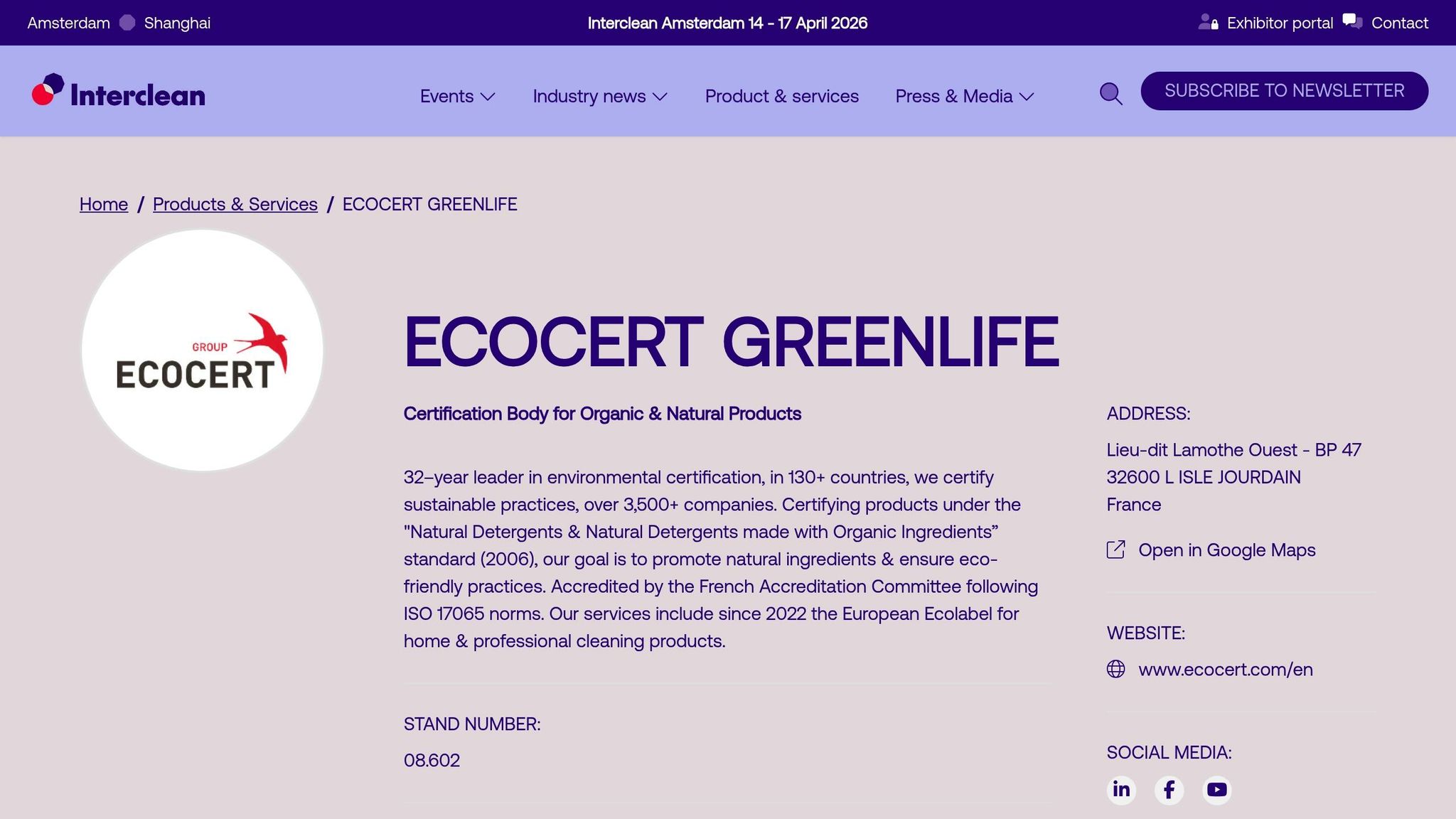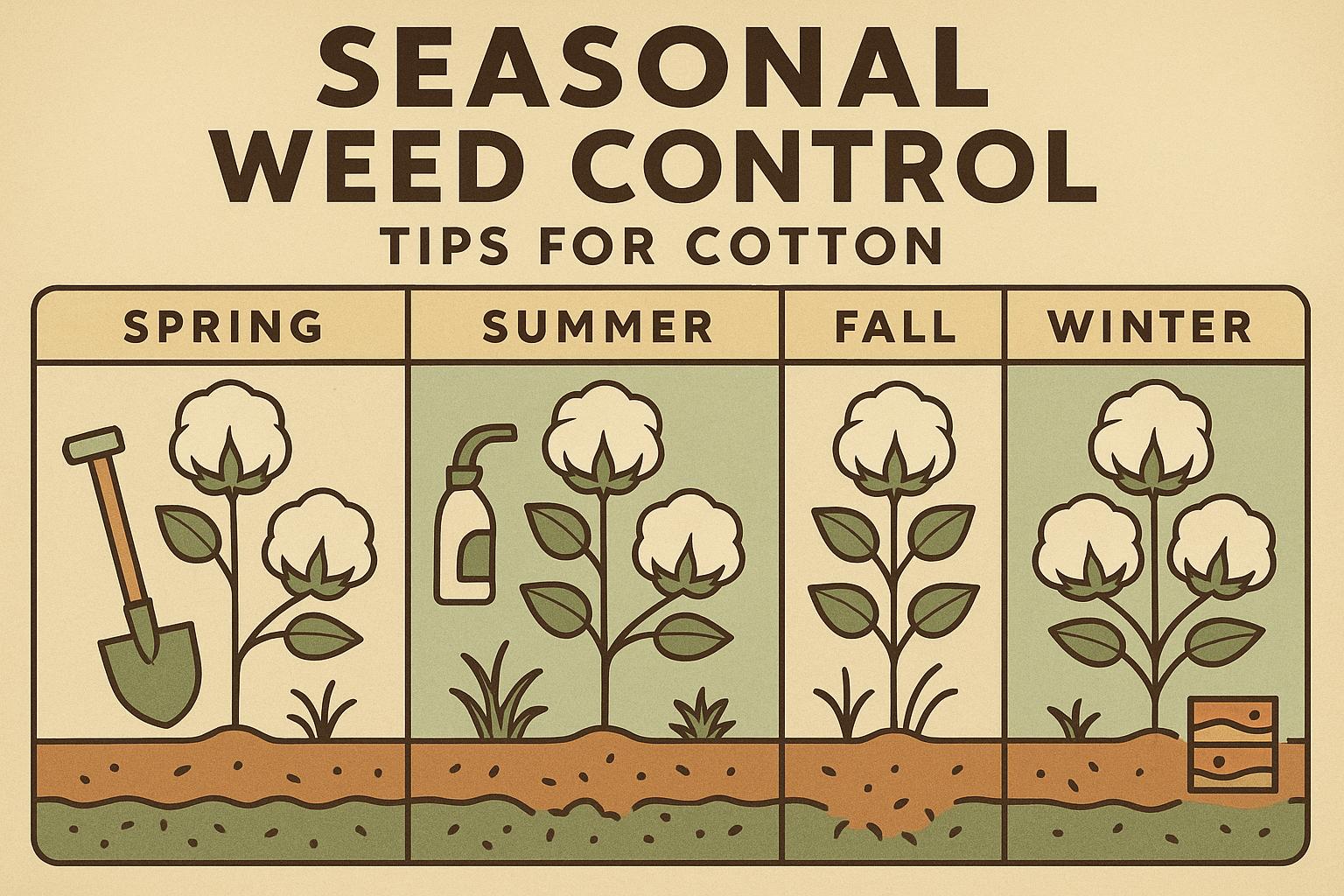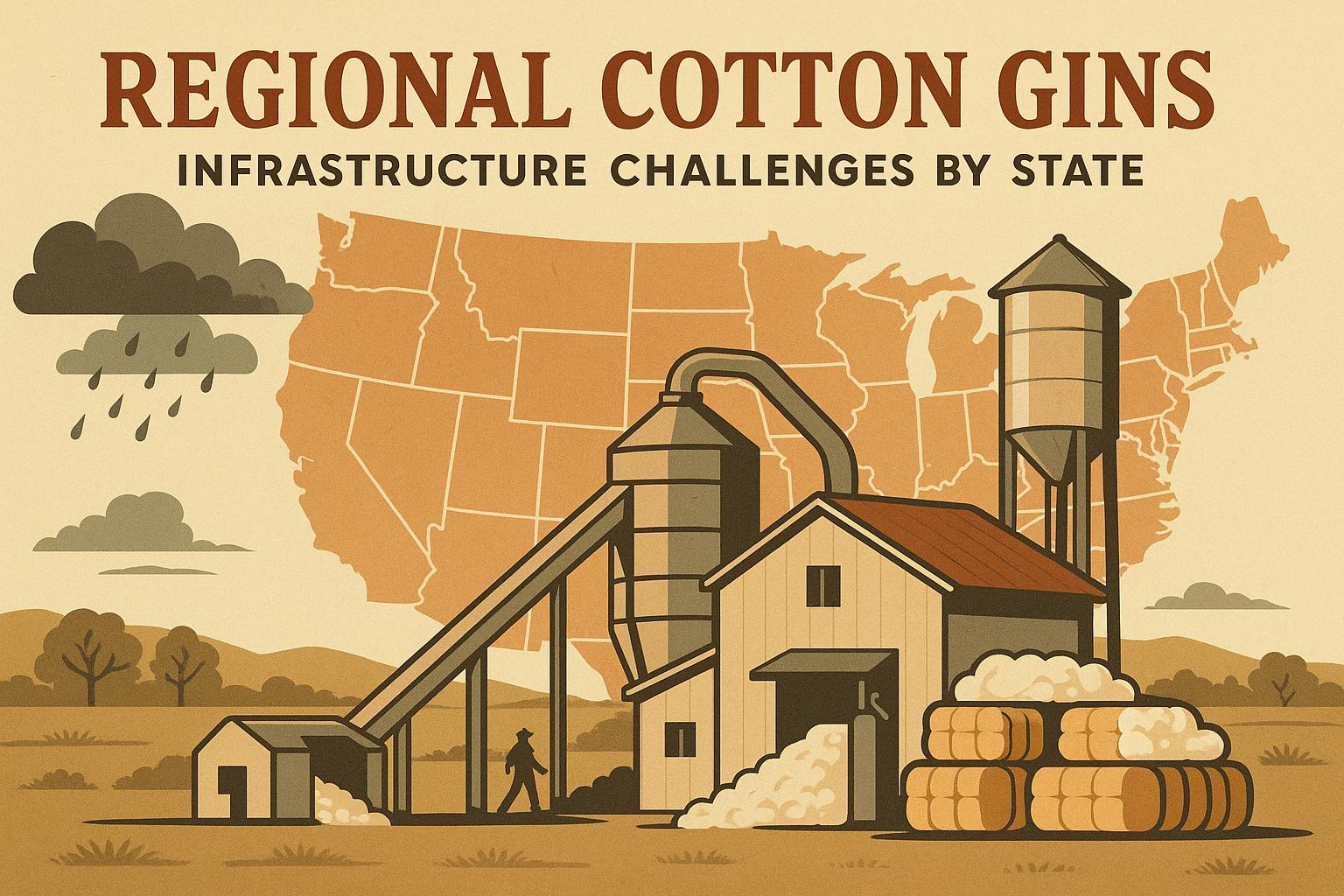To achieve GOTS certification for your cotton gin, focus on these key steps:
- Register with a Certification Body (CB): Begin by applying to a GOTS-approved CB, such as Control Union or Ecocert. They will audit your facility for compliance.
- Source Organic Cotton: Only process cotton from farms listed in the GOTS Farm-Gin Registry. Ensure transport stays within the 310-mile (500 km) limit.
- Maintain Documentation: Keep detailed records, including Transaction Certificates (TCs), Scope Certificates (SCs), GMO/pesticide test results, and transport logs. All records must trace cotton back to its origin.
- Conduct Testing: Test raw cotton for GMOs and lint cotton for pesticides annually using GOTS-approved labs.
- Prepare for Audits: Be ready for annual inspections and unannounced audits. Keep records organized and accessible.
- Renew Certification Annually: Schedule inspections at least 60 days before your Scope Certificate expires.
Basic Requirements for GOTS Certification
Registering with Certification Bodies
If you're operating a cotton gin and aiming for GOTS certification, the first step is registering with a GOTS-approved certification body (CB). These organizations are responsible for auditing and certifying your facility. In the United States, examples of such certification bodies include Control Union, Ecocert, and OTCO (Organic Crop Improvement Association).
The process kicks off with an application to your chosen certification body. Once your application is reviewed, the CB will arrange an initial audit to evaluate whether your facility meets GOTS compliance standards. Be sure to have all necessary documentation ready as outlined by the CB to streamline the process. Additionally, confirm that all cotton processed in your facility adheres to GOTS sourcing protocols.
Sourcing Requirements for Organic Cotton
Adhering to GOTS sourcing standards is non-negotiable. All raw cotton processed in your gin must come from farms or farm groups listed in the GOTS Farm-Gin Registry, also referred to as the Global Fibre Registry. This ensures complete traceability of the cotton.
Transportation of raw cotton is restricted to within 310 miles (500 kilometers) of the certified farm, so planning your supplier network carefully is essential to remain compliant.
Before the harvest season begins, gin operators must identify and declare their cotton producers. This step promotes accountability and simplifies the verification process during audits conducted by certification bodies.
Accurate record-keeping is another critical requirement. Maintain detailed financial and transport records, including payment receipts, invoices, transaction certificates, bale and lot numbers, and supply chain identifiers. These documents are vital for demonstrating the chain of custody for the cotton you process.
Cotton must be sourced directly from registered farms or farm groups, and you’ll need documentation to prove this relationship. Purchases through intermediaries are not permitted. For U.S.-based operators, tools like cottongins.org can help locate certified organic farms and other GOTS-certified gins nearby, making it easier to build a compliant supply chain and manage logistics efficiently.
Documentation and Traceability Requirements
Required Documentation Checklist
Having the right documentation ready for audits is a must. Your GOTS certification hinges on keeping everything organized and accessible.
Transaction Certificates (TCs) are the backbone of your compliance. Each TC must clearly outline the chain of custody, starting with the farm TC number listed on the first certificate issued by the gin. Gin-level TCs should detail the transformation of raw cotton into lint cotton, including bale and lot numbers for the tested raw cotton, farm TC numbers (if applicable), and the Scope Certificate (SC) numbers for the farm(s) or farm group involved in the process.
Scope Certificates are equally important. You need up-to-date copies for your certified operations and every farm or group you source from. If a farm or group holds multiple organic certifications, ensure all SCs are uploaded to the Global Fibre Registry (GFR) and shared with relevant parties. Keep a close eye on SC expiration dates to avoid sourcing from uncertified farms.
GMO and pesticide test reports must be meticulously recorded. These reports should include bale and lot numbers, farm TC numbers (if applicable), and SC numbers for the farm(s) or group. Submit test results to the certification body before selling the fiber. If contamination is detected, the cotton must be held until cleared by the certification body.
Financial documentation is critical for proving legitimate sourcing. Maintain records like payment receipts, invoices, and transaction details that show direct purchases from registered farms. This is especially crucial when organic and GOTS SCs are linked to entities with different tax identification numbers.
Transportation records help ensure compliance with distance regulations. Keep shipping manifests, delivery receipts, and distance calculations to verify adherence to transportation limits.
This thorough documentation process ensures traceability at every stage of production.
Traceability and Lot Tracking
Lot tracking is essential for accountability and transparency throughout your operations. Every raw cotton lot must be documented with details that trace back to the field.
For each incoming lot, record key information such as the farm or group name and registration number, the region, state, and province of origin, the harvest volume, and the date it arrived at your gin. Additionally, include the farm TC number, bale and lot numbers from testing, and the name of the lab that conducted GMO and pesticide tests.
Report all incoming raw materials to GOTS, ensuring traceability to the farm group, including the region, state, and province of origin. Your tracking system should connect each batch of raw cotton to its lint cotton output, noting any processing losses and their causes.
A well-designed system allows quick retrieval of information about any lot, whether for audits or quality checks. Transport details - such as the distance traveled from farm to gin and the transport date - should also be documented, creating a complete audit trail from the field to processing.
Sample retention is another key aspect of traceability. Certification bodies are required to hold raw and lint cotton samples for at least three years. Organize these samples with clear labels that match your lot tracking system.
Maintaining accurate records simplifies both scheduled and unannounced audits.
Audit Requirements
Your organized documentation plays a vital role in meeting GOTS audit standards. Annual on-site audits are mandatory for all certified sites and subcontractors. Traders without subcontractors may qualify for remote inspections. These inspections should occur at least 60 days before the Scope Certificate expires to ensure timely renewal.
GOTS has also increased unannounced audits in high-risk areas, making it essential to keep your records audit-ready at all times - not just during scheduled inspections.
To prepare for audits, maintain comprehensive files that include all Transaction Certificates issued during the audit period, detailed records of raw cotton sourcing (with farm names, locations, and registration numbers), and documentation of GMO and pesticide testing, including results and dates. Ensure you have proof of compliance with the 310-mile transportation limit, as well as financial records for raw cotton purchases and any corrective actions from past audits.
For unannounced audits, keep these documents easily accessible. Maintain an up-to-date list of all certified farms and farm groups you source from. Certification bodies will also verify your gin's throughput, raw cotton processing capacity, and lint cotton output against the documented volumes on Transaction Certificates. Be sure to have records of machine capacity and loss percentages available.
Before issuing a TC, certification bodies conduct a thorough review, including a plausibility check with volume reconciliation. This detailed process ensures accountability at every step, reinforcing trust in the GOTS supply chain and supporting buyers in their decisions.
Testing and Quality Control Procedures
GMO and Pesticide Testing
Every year, organic cotton must undergo testing before the ginning process begins. According to GOTS standards, raw cotton is tested for genetically modified organisms (GMOs) using applicable ISO protocols, while lint cotton is analyzed for pesticide residues to ensure it meets GOTS limits.
To maintain traceability, label each sample with its bale and lot numbers, along with the farm's Transaction Certificate (TC) and Scope Certificate (SC). This labeling system ensures a clear chain of custody throughout your operations.
Test results must be submitted to your GOTS-approved certification body before processing or selling the cotton. Only after results are reviewed and approved will a Transaction Certificate (TC) be issued, safeguarding the integrity of the certified supply chain.
It's crucial to work with accredited laboratories that follow GOTS-approved protocols. These labs ensure that your testing aligns with required standards.
Accurate testing is the backbone of your quality control system. It not only ensures compliance but also provides a foundation for corrective actions when necessary. Proper documentation of these tests is essential for both routine and surprise audits.
Handling Non-Compliance
Even with rigorous testing, non-compliance can occur. If tests reveal GMOs or pesticide residues above GOTS limits, follow these steps to address the issue:
- Segregate any non-compliant batches immediately to prevent cross-contamination.
- Notify your certification body, which will decide whether the cotton can be re-tested, must be downgraded, or requires other corrective actions. No GOTS-certified sales can proceed until the issue is resolved.
For every non-compliance event, document the details thoroughly. This includes the nature of the issue, specific corrective actions taken, and all communications with the certification body. Be sure to include dates, the personnel involved, and the final outcome.
If re-testing is approved, ensure that the same accredited laboratory and sampling protocols are used. Label and track the new samples just as carefully as the originals.
In some cases, certification bodies may require a corrective action plan. This might include additional inspections, stricter testing protocols, or changes to sourcing practices. To stay compliant, update your procedures as needed and provide regular training for your staff.
Unannounced audits are increasingly common, particularly in areas considered higher risk. During these inspections, auditors will examine your sampling methods, test records, and documentation of past non-compliance incidents. To stay prepared, make sure your systems are always ready for review.
Ongoing staff training is key. Ensure your team understands how to handle non-compliance, including techniques for segregation, proper documentation, and effective communication with certification bodies. This helps maintain consistency and readiness across your operation.
Maintaining Certification and Compliance
Annual Inspections and Certificate Renewal
GOTS Scope Certificates are valid for just one year, so renewing on time is essential to keep operations running smoothly. Every GOTS-certified cotton gin and its subcontractors must complete at least one onsite inspection each calendar year to maintain their certification status.
To avoid any interruptions, schedule your annual inspection at least 60 days before your certificate expires. This gives you enough time to address any issues and complete the renewal process without risking a lapse in certification. The renewal process builds on the documentation and audit practices already in place.
During the onsite audit, a GOTS-approved certification body will evaluate your compliance with all GOTS requirements. This includes reviewing your sourcing practices, traceability systems, quality control measures, documentation, physical operations, and storage facilities. Inspectors will also confirm that your gin processes only organic cotton sourced from farms listed in the GOTS Farm-Gin Registry.
Make sure all required documentation is up-to-date and complete before the inspection. This includes GMO and pesticide residue test results, transaction records, transport documents, and volume reconciliation logs. Missing or incomplete documentation can delay the renewal process and disrupt your business operations.
Inspectors will also ensure that transport of raw cotton complies with the 500-kilometer limit from farm to gin.
Record Keeping and Monitoring
After the inspection, maintaining detailed records is crucial for staying compliant. Effective record keeping supports both your certification and future audits. Keep thorough documentation of all procurement, transport, testing, and certification activities.
Your record-keeping system should include items like purchase and sales invoices, transport documents, GMO and pesticide test reports, volume reconciliation logs, and transaction certificates. Organize these records for easy access during audits. Digital systems can help you track each cotton batch from farm registration through ginning, linking all documentation by lot number and supplier. This ensures you're ready for both scheduled reviews and surprise audits.
For quality assurance and potential audit needs, retain samples for at least three years.
The GOTS Farm-Gin Registry is a key tool in compliance monitoring. It connects each batch of organic cotton back to its originating farm, detailing harvest volumes and certification information. Auditors use this registry to confirm that only registered and certified cotton enters your supply chain.
Staying compliant between annual inspections requires active monitoring. Surprise audits are becoming more common, especially for higher-risk operations. Conduct regular internal audits to review your documentation, verify supplier registrations, and ensure all processes meet GOTS standards. Assign a compliance officer to oversee GOTS-related documentation and create a calendar with reminders for key deadlines.
Staff training is equally important. Make sure your team understands GOTS requirements, documentation protocols, traceability systems, and how to address non-compliance issues. A well-trained team minimizes errors and helps maintain certification during routine and unexpected inspections.
Finally, maintain open communication with your certification body throughout the year, not just during inspections. Address concerns early and work collaboratively to resolve any potential issues before they escalate.
sbb-itb-0e617ca
Benefits of GOTS Certification for Cotton Gins
Market Access and Consumer Trust
Earning GOTS certification unlocks access to high-value markets. Many major U.S. and European brands now require GOTS certification throughout their supply chains, making it more of a necessity than an optional credential.
Certified organic cotton not only fetches premium prices but also attracts long-term contracts with buyers focused on sustainability. This reinforces confidence among consumers who are increasingly seeking transparency in sourcing and production.
The growing demand for responsibly sourced products is largely driven by consumer awareness. Buyers today want more than marketing claims - they expect evidence of ethical and sustainable practices. GOTS certification provides this assurance by adhering to strict environmental, social, and traceability standards.
Another advantage lies in the global recognition of GOTS. As a widely accepted benchmark for organic textiles, GOTS certification earned in the U.S. can open doors to international markets. This global credibility helps smaller gins compete by showcasing their adherence to rigorous standards.
The U.S. organic cotton market is also expanding, with GOTS-certified fiber volumes increasing every year. This reflects a rising demand for sustainable products and a stronger commitment from retailers to responsible sourcing.
These market benefits build on the solid compliance measures required by GOTS. By meeting these high standards, your gin not only adheres to regulations but also gains a competitive edge in the marketplace. Leveraging online platforms can further amplify the benefits of certification.
Using cottongins.org to Expand Visibility

To capitalize on these market advantages, listing your gin on cottongins.org can significantly boost its visibility among buyers focused on certified suppliers. This platform serves as a go-to directory for brands, supply chain partners, and other buyers seeking GOTS-compliant suppliers.
By listing your GOTS-certified gin, you make it easier for potential buyers to find you. Many buyers actively search for certified suppliers to build their organic textile supply chains, and showcasing your certification status can directly lead to new contracts and partnerships.
The platform’s "Submit A Gin" feature allows operators to add their facility to the directory, ensuring they’re easily discoverable. For those looking to stand out even more, sponsorship opportunities offer additional marketing perks.
Here’s a breakdown of the sponsorship options:
| Sponsorship Type | Monthly Cost | Key Benefits |
|---|---|---|
| Sponsored Post | $200 per post | Top placement for one day, social media sharing, permanent archive |
| Official Sponsor | $200/month | Footer logo placement, backlink, and a free sponsored post with annual commitment |
| Featured Sponsor | $400/month | Premium site placement, footer logo, and two free sponsored posts annually |
In addition to listing your gin, the platform connects operators with industry updates and potential partnerships that can guide strategic decisions - especially when navigating GOTS certification requirements.
To maximize visibility, emphasize your GOTS certification prominently in your profile and any sponsored posts. This can set your gin apart when buyers are evaluating potential suppliers.
Finally, the platform’s mailing list and social media integration expand your marketing reach. Sponsored posts are shared across social channels, helping you connect with a broader audience. Regularly updating your listing after certification renewals and sharing relevant industry insights can further demonstrate your commitment to meeting GOTS standards and staying ahead in the market.
The stages of Textile (GOTS, GRS) audit with Ecocert Greenlife

Conclusion
Securing GOTS certification involves a step-by-step process, from initial registration to yearly renewals. Once compliance is achieved, the doors to significant market opportunities naturally open.
To stay on track, schedule annual inspections at least 60 days before your certificate expires and keep detailed records to ensure you're always ready for audits. Cotton gin operators must also verify that all sourcing and processing activities align with GOTS standards, as unannounced audits may occur in high-risk scenarios.
Certification under GOTS strengthens market access and builds buyer trust. Many major brands require GOTS compliance across their supply chains, and certification can help you secure contracts with these industry leaders. Platforms like cottongins.org can further enhance visibility, connecting certified suppliers with buyers actively seeking responsible partners.
As the organic cotton market grows, driven by consumer demand for sustainable products and retailers' commitment to ethical sourcing, maintaining GOTS compliance becomes even more crucial. Cotton gins that consistently meet these standards are not only well-prepared to thrive in this expanding market but also positioned to gain a competitive edge in the evolving textile industry.
FAQs
What happens if a cotton gin does not meet GOTS certification requirements during an audit?
Failing to meet GOTS certification standards during an audit can lead to significant repercussions. These might include the suspension or even revocation of your certification, which directly affects your ability to label and market products as GOTS-certified. Beyond that, non-compliance can harm your reputation and result in financial setbacks, especially if you can no longer sell products under the GOTS label.
To steer clear of such issues, it's crucial to adhere to all certification requirements. Keep thorough documentation, ensure your processes align with the necessary standards, and conduct regular internal checks. Staying informed about the latest GOTS guidelines can also help you stay prepared and ensure a smoother audit process.
What steps can a cotton gin take to ensure traceability and compliance with GOTS standards when handling organic cotton?
To meet GOTS standards and ensure proper traceability, cotton gins need to have clear processes in place and maintain thorough documentation at every step. Start by confirming that all organic cotton suppliers provide valid certifications proving they meet GOTS requirements.
Keep detailed records for each batch of cotton processed. These records should include essential details like the cotton's origin, supplier information, and certification data. This level of documentation not only supports transparency but also makes audits much easier.
It’s equally important to implement strict segregation measures to ensure organic cotton remains separate from non-organic fibers during both processing and storage. To strengthen compliance and enhance traceability, regular staff training on GOTS guidelines is key. This helps ensure everyone involved understands and follows the necessary protocols.
How can cotton gins prepare for unannounced GOTS audits and stay compliant year-round?
To get ready for unannounced GOTS audits, cotton gins should focus on building a solid compliance plan. This means keeping documentation current, ensuring all operations align with GOTS standards, and providing regular training for staff on certification requirements. Detailed records of sourcing, production, and quality control are key to showing compliance when an audit happens.
Staying prepared all year involves scheduling regular internal reviews, quickly addressing any compliance gaps, and keeping up with changes to GOTS regulations. By promoting a mindset of ongoing improvement and adherence to standards, your cotton gin can confidently navigate unannounced audits while upholding certification requirements.


